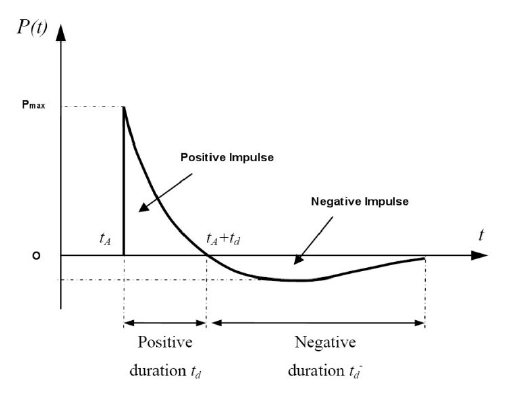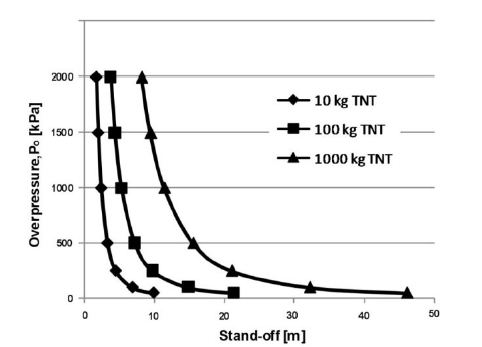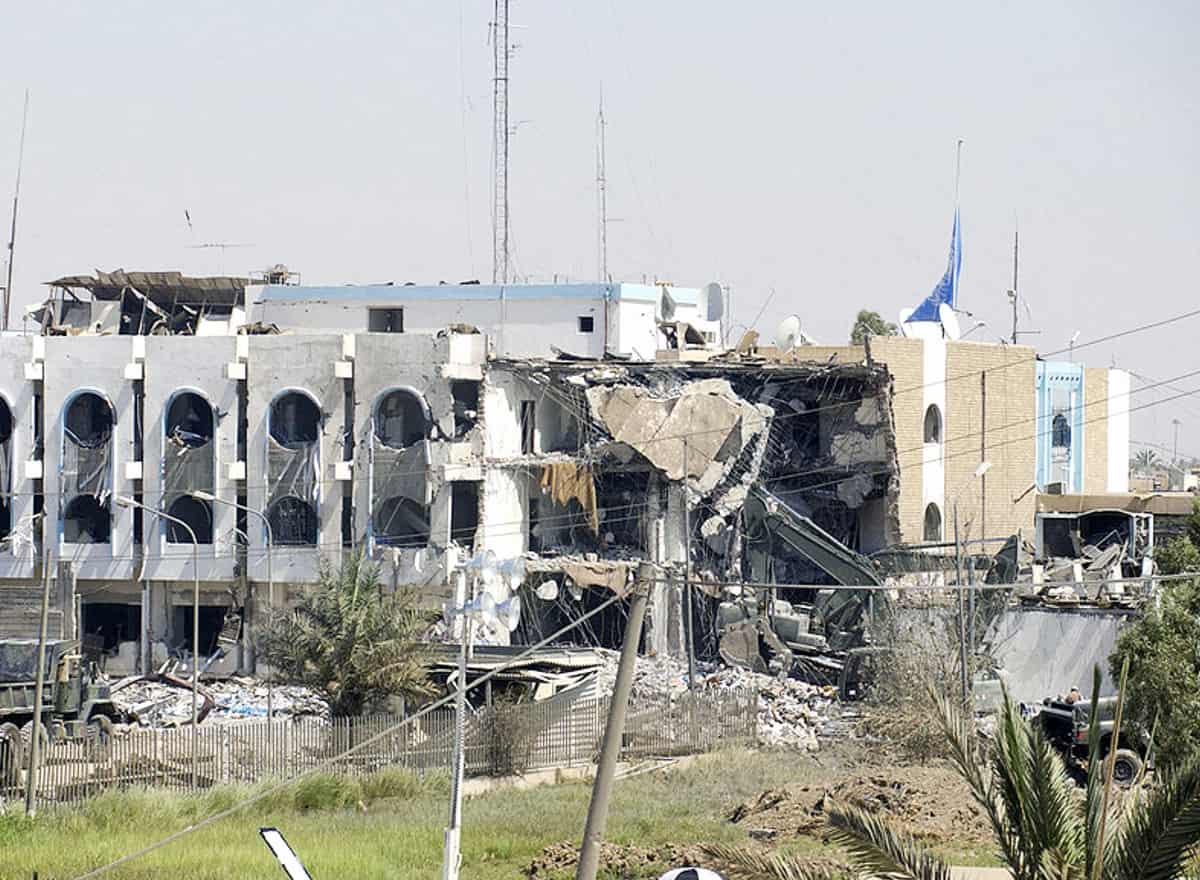Understanding the Anatomy of an Explosion
As physical protection experts, one of our biggest concerns is explosive attacks.
Bombs and explosive devices have proven to be particularly destructive and dangerous for both people and structures. As we pointed out in our blog post about embassy attacks, explosive devices have become the weapon of choice for those who want to harm a building and its inhabitants. But why is that the case? Why are explosions so effective, and what threat do they pose?
In this blog, we first look at explosions, starting with the chemical reactions and physical processes that determine their strength. Then we examine the threats they represent, including attack methods and their mechanisms of damage to buildings and people.
Explosive Events: A Deep Dive into the Blast
Let’s start by defining some basic but important terms: “explosion” and “blast.”
In short, an “explosion” is a rapid release of energy in the form of sound, heat, light, and shock waves. “Blast” is the initial shock wave (or movement of air) created by the explosion.
To understand the effect of the blast on buildings, it is important to break down an explosive event into several steps:
- The explosive material (liquid or solid) “detonates,” meaning it is transformed from its original state into a hot, high-pressure gas.
- To reach equilibrium with the surrounding air, the explosion product expands rapidly, creating a shock wave made of highly pressurized air
- This shock wave moves radially outward from its source (the explosive material) at supersonic speed. As it expands, the pressure drops rapidly due to the energy spreading and geometric divergence. This typically happens in milliseconds.
- The initial shock wave is only one-third of the total release of chemical energy. The remaining two-thirds are released more slowly as the products of detonation create an “afterburning process,” slower than the original explosion and detonation.
- These secondary shock waves (or “stress waves”) also carry an enormous amount of energy and will pass through surfaces, bodies, and tissues, creating immense damage.
- At the site of the explosion, a vacuum (or blast wind) occurs due to the rapid expansion of the explosion (blast). If the blast can be seen as a push effect, the vacuum is more of a pull, as it draws in the surrounding atmosphere. This high-intensity vacuum can cause objects, glass, or debris to be pulled back toward the explosion site.
Predicting the Damage: What are the Factors Determining the Effects of an Explosion?
Predicting the Damage: What are the Factors Determining the Effects of an Explosion?
- The first thing to consider is the amount and type of explosives used: Higher amounts of explosive materials tend to lead to larger, more destructive events.
- Secondly, the specific type and composition of the material (e.g., TNT, C4, Semtex, HMX) also dictate the explosion’s strength.
- Thirdly, the distance between the detonation and the structure (the standoff distance) also plays a critical role.
- Fourthly, the architecture and building materials of the building are key to predicting how they will protect against an explosion. Blast-resistant buildings generally withstand explosions better than “ordinary” buildings. Of course, this is not a guarantee.
But these criteria alone are not enough to predict the potential damage caused by a blast. One must also consider the pressure created after the initial explosion and the physical interaction (including the angle of incidence) with the surrounding structures.
There are two types of pressure to worry about when considering explosive events:
- The peak incident pressure, determined by the explosives themselves and the distance to the blast area. In short, this is the force of the original explosion itself.
- The reflected pressure: This particular type of pressure varies depending on the surface angle affected by the shock wave. For example, when the explosion wave and the surface are parallel, the reflected pressure is minimized. But when the explosion wave hits a structure at a 90-degree angle, the reflected pressure is extremely strong. Reflective pressure is something to really consider when thinking about building damage. Depending on the angle of incidence, the reflected pressure for detonations can be almost 13 times greater than the maximum incident pressure.
When talking about pressure, one must also consider the impulse. In physics, impulse is the measurement of a given force over a specific time interval. Remember that even though explosions occur over a very short period, they are not instantaneous. The pressure rises dramatically, then falls, and oscillates – but doesn’t disappear immediately.
The easiest way to understand impulse and pressure would be to look at a graph like this:

In the graph above, we can see the peak of pressure, that point on the waveform where the pressure is at its highest (Pmax). The stress waves are the pressure over time. Everything below the curve would be the impulse itself. We can see it oscillate over time following the pattern of pressure.

Here’s another graph focusing on standoff distance and overpressure – the pressure caused by a shockwave above normal atmospheric pressure.
As we can see, the effects of an explosion can be felt at shorter or longer distances, depending on the amount of explosive material used. The maximum amount of overpressure represented here (2000 kilopascal) spreads much further with larger amounts of TNT.
That’s why it’s crucial to consider pressure, impulse, distance, and all the different energies released during an explosion and evaluate them. We need to fully understand these explosive events – and the physical effects they can have – to best help protect structures and minimize the amount of energy that can be imparted to them.
Bringing Explosive Threats to Buildings: Delivery Methods
When considering threats to buildings – and people in or near them – we also need to be mindful of the delivery methods for the explosive payload.
For explosive threats, there are two general delivery categories:
- Vehicle-borne bombs, which can be termed vehicle-borne improvised explosive devices (VBIEDs), large vehicle-borne IEDs (LVBIEDs), and very large vehicle-borne IEDs (VLVBIEDs). This delivery method typically involves large amounts of explosives detonated at a critical location. The size (ordinary, large, very large) refers to the size of the vehicle and the expected payload (e.g., a sedan with 200 kilograms of explosives compared to a truck with several tons).
- Hand-carried, also called Personal-Borne IEDs (PBIEDs). While payloads are often smaller than VBIEDs, the impact can be just as destructive – if not more. Bombs delivered by individuals can be detonated inside buildings, can be easier to conceal, and can be detonated in less secure locations.
Blast Damage to Buildings and People
Structures don’t exist in a vacuum. They are often populated, and many of them are not isolated – there may be other buildings around and passersby in the area. Therefore, threats from explosive events should be divided into two main parts: damage mechanisms on buildings and injury mechanisms on people.
For buildings themselves, there are three major damage mechanisms:
- The explosion itself or direct air blast effects. The damage caused by this first step is determined by the conditions we defined and the steps discussed in the first part of this article. The detonation, shock waves, vacuum, the amount and type of explosives, and the pressure (both incident and reflected) created by the explosive event. The direct air blast can also result in flying effects that further damage the structure.
- Collapse: When a building is hit (directly or indirectly), parts of its structure are at risk of collapsing. This is the most severe building response to an attack. This collapse can be immediate (e.g., a wall or beam destroyed by the explosion), but it can also be a progressive collapse. This happens when local structural failures propagate to other elements in the buildings, leading to a chain reaction that results in more damage and/or collapse.
- Damage to nearby structures: Explosions targeted at a building often impact nearby buildings. Either the explosion itself is powerful enough to reach structures nearby (e.g., a shock wave that shatters windows), or a collapse of the main target will damage surrounding buildings, or effects will be propelled with enough force to hit these buildings.
Injury mechanisms for people by severity:
- General collapse: According to FEMA, previous incidents have shown that collapses have led to the most extensive number of deaths. Most fatalities are due to blunt impact and crushing. While survivors may survive the initial collapse, it is quite common for victims to end up trapped under concrete slabs.
- Partial collapse: Lack of an outer wall, floor collapse, and other parts of the building collapsing (while it remains standing) can also lead to fatal injuries, such as skull fractures and concussions.
- Flying effects: Glass windows, fixtures, and other building materials quickly become dangerous after an explosion, leading to cuts and abrasions and worse. While seen as less severe than other injury mechanisms, flying effects often result in many injuries, as a shock wave can reach buildings hundreds of meters away and shatter their windows.
How are People and Structures Protected from this Growing Threat?
From Oklahoma to Nairobi, it is clear that explosion-based attacks are a significant threat to both buildings and people.
Their effectiveness, the damage they can inflict, the attention they draw, and the ease with which people can be injured have made car bombs and hand-carried bombs a staple in terrorist attacks over the past few decades. Embassies, tourist sites, and government buildings continue to be targeted several times a year worldwide.
In our next blog, we will take a closer look at how we can protect ourselves from this growing threat.
While we may not always be able to prevent terrorists from reaching their destination, we can prepare our buildings to better withstand explosions – for example, by increasing the distance between explosive equipment and structure to reduce blast effects or directly improving the structure itself by making it stronger, more massive, and/or more flexible.
Be sure to check back to learn more about the importance of structural design and how ensuring a building’s perimeter, shell, and core can help mitigate explosive attacks.


